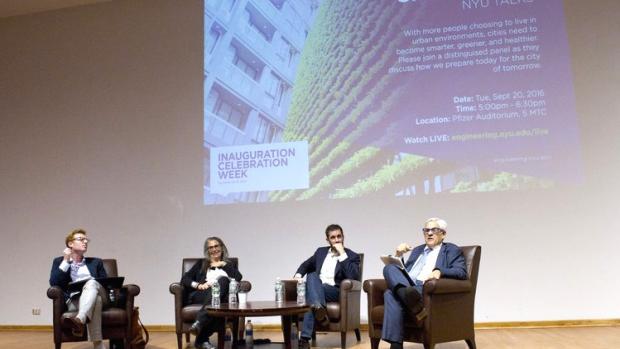Universities and Cities ... Better Together
NYU Tandon Hosts a Panel Discussion on Smart Cities and Why University Partnerships are Vital

On September 20, as part of the Inauguration Celebration Week honoring NYU President Andrew Hamilton, the Tandon School of Engineering hosted a panel discussion on smart cities — urban areas that deploy information and communication technology (ICT) in their efforts to be more efficient, cleaner, and safer.
The panel was moderated by Ben Levine, the interim director of the MetroLab Network, and included Mitchell L. Moss, the Henry Hart Rice Professor of Urban Policy and Planning and director of the Rudin Center for Transportation Policy and Management at NYU Wagner; Constantine Kontokosta, an assistant professor of civil and urban engineering and deputy director for academics at Tandon as well as head of the Quantified Community at the Center for Urban Science and Progress (CUSP); and Pat Sapinsley, the managing director of Tandon’s Cleantech Initiatives, including ACRE, the Urban Future Lab, and Powerbridge.
To those who might have been wondering why a discussion of smart cities had been scheduled during inauguration celebrations for NYU’s new president, Tandon Dean Katepalli Sreenivasan, who kicked off the evening, reminded the audience that NYU is a university both in and of the city, and that each has a profound effect on the other.
Levine, whose organization encompasses partnerships among more than 40 institutions of higher learning and more than 30 city governments, concurred, explaining that urban areas can serve as living laboratories for academic researchers, while the research coming out of universities can keep cities on the cutting edge.
The conversation roamed freely — from how companies are making solar panels more attractive from a design perspective to goals for substantially reducing pollution over the coming decade; from the need for better methods of wayfinding to how to use the information gleaned from the 18 million 311 calls made each year in the city; from how an outbreak of cholera led to improvements in New York’s water supply system to the ramifications of wearable technology.
In the end, all agreed: it takes smart people to build smart cities, and NYU is supremely situated to be involved.




